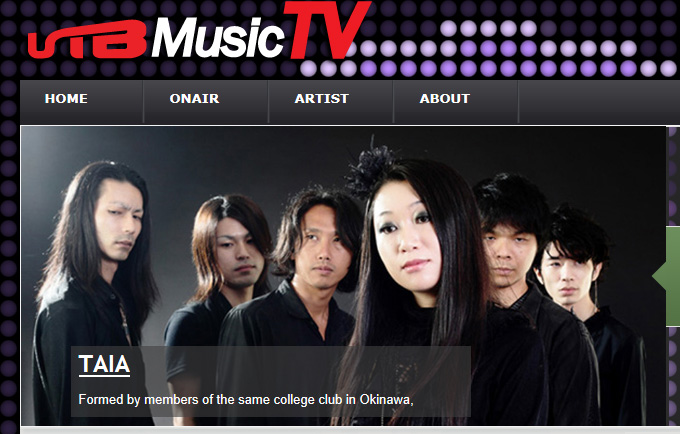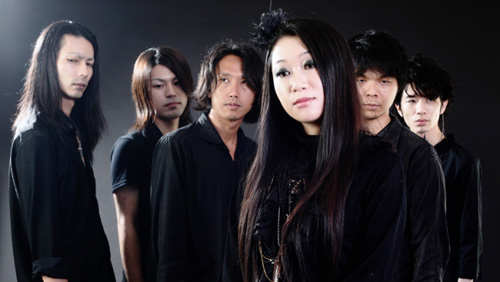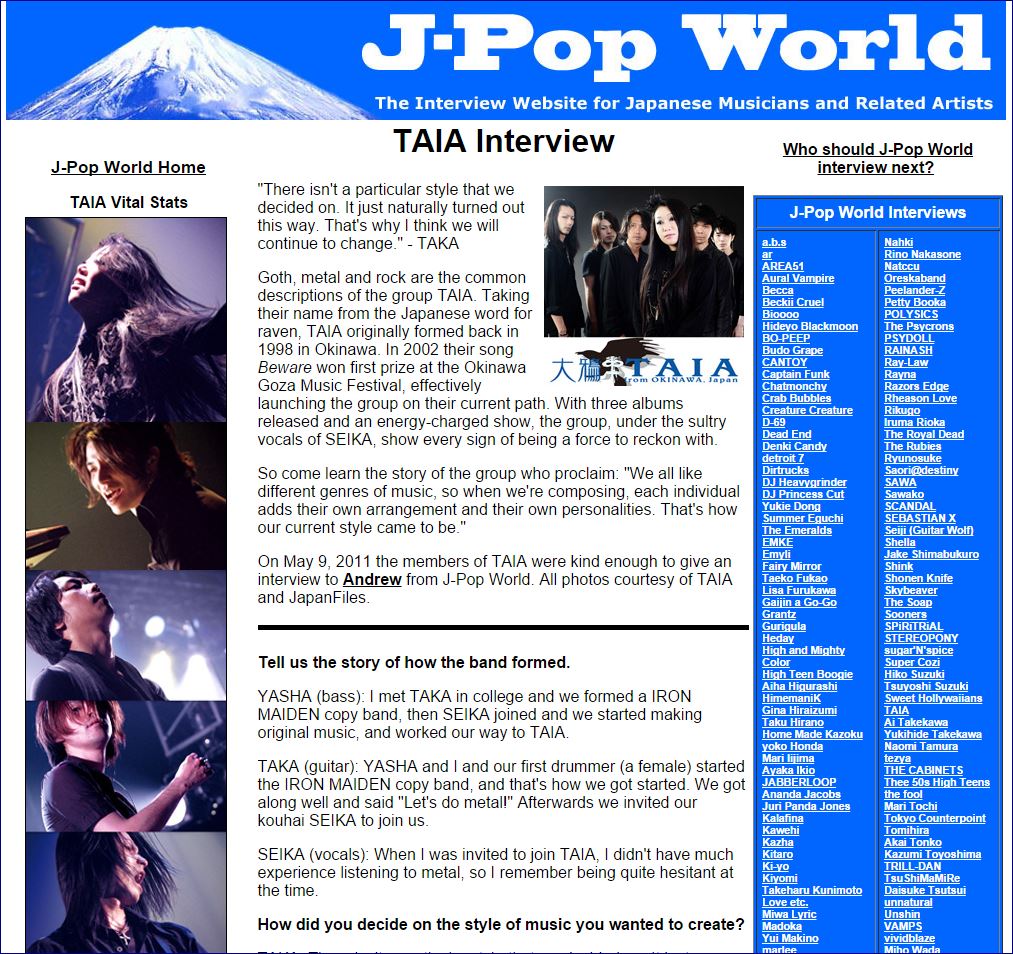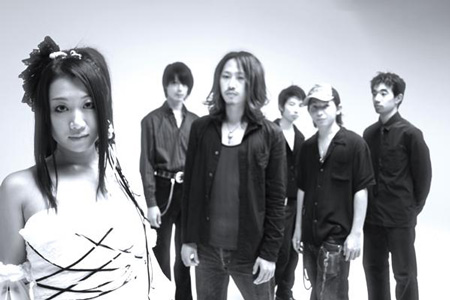
TAIA’s music videos start airing in rotation on L.A. television station UTB 18.2′s “UTB MUSIC TV” on 6/30 @10:30pm.
“Magnolia”
“Kazamai”

TAIA’s music videos start airing in rotation on L.A. television station UTB 18.2′s “UTB MUSIC TV” on 6/30 @10:30pm.
“Magnolia”
“Kazamai”

Link:
http://www.jame-world.com/us/articles-75263-interview-with-taia.html

Link:
http://www.j-popworld.com/Interviews/TAIA.php
[REPRINTED BELOW]

Tell us the story of how the band formed.
YASHA (bass): I met TAKA in college and we formed a IRON MAIDEN copy band, then SEIKA joined and we started making original music, and worked our way to TAIA.
TAKA (guitar): YASHA and I and our first drummer (a female) started the IRON MAIDEN copy band, and that’s how we got started. We got along well and said “Let’s do metal!” Afterwards we invited our kouhai SEIKA to join us.
SEIKA (vocals): When I was invited to join TAIA, I didn’t have much experience listening to metal, so I remember being quite hesitant at the time.
How did you decide on the style of music you wanted to create?
TAKA: There isn’t a particular style that we decided on. It just naturally turned out this way. That’s why I think we will continue to change.
URA (guitar): That’s right. We all like different genres of music, so when we’re composing, each individual adds their own arrangement and their own personalities. That’s how our current style came to be.
KEN (drums): All the members seem to be doing things they want to and like to do.
FUGA (keyboard): Right now there really isn’t a time where we all get together and decide the music style before we compose a song. Someone will bring in the music, and each member adds their own arrangement and performance, and that’s the current style. Sometimes the composer might have certain requests, but basically there’s a lot of freedom.
“KAZAMAI” is one of our favorite songs of yours. Can you tell us the story behind writing and recording it?
TAKA: KAZAMAI is the very first song that we actually recorded with professional engineers, and the recording process was really tough. We didn’t know the minimum skills required for recording, and didn’t know how the recording process worked… But I think through this experience our awareness has changed.
SEIKA: TAIA’s music starts with the guitar riff, then we add the song’s melody and lyrics. For KAZAMAI, from the first time I heard the riff, I immediately connected it to the grandness and gorgeousness with the classic Japanese literature, so I wrote the lyrics in that direction. I remember it was hard to play during the tempo change.
FUGA: Actually we recorded this song twice, and we’ve released it twice as well. From the keyboard standpoint, in order to create a Japanesque atmosphere, I try to add Japanese instruments during the bridge and to each verse. But at the time we made the song, my personal levels of arrangement and musical composure were not as good, so when I re-listen to the song I still want to add things to it.
The music video for “KAZAMAI” creates a great look and energy for your band. What was it like making the video, and where did the ideas for it come from?
SEIKA: The PV was made up of the performance from several different angles, so we played the same song over and over again during shooting. That’s why, as shooting progressed, all the members got better at playing it! (laugh) When we were shooting the parts where I’m dancing, I had no idea at the time what it would look like, but when I saw the edited footage I was really happy with how good it came out!
FUGA: All the PVs we’ve made before and after that are made up of different scenes, and you can generally divide them by the story scenes and the performing scenes. But for KAZAMAI, there was only one location, and it’s made up of just performing scenes. I think that really conveyed the band’s energy.
YASHA: Because the PV prior to that (Prayer) was more about location shooting, we decided to make this one more like a live-format. We wanted an aggressive style for the shooting.
FUGA: Even though we had to shoot the same scene over and over, it didn’t feel hard. We had a lot of fun.
YASHA: We kept our energy at 100% for the entire shoot, and when it was over, I think I was even more tired than having done a live…!
SEIKA: And the one fun thing about PV shooting is that I can enjoy watching the other members’ playing their instruments! I never get to do that during a live show, so that was really enjoyable and fun.
“Bewhere” is another song that we like. Why is that song special for you?
YASHA: This is a very important song for TAIA. I believe it’s because we made this song that we were able to determine the direction for TAIA as a band.
TAKA: This song is the song that gave us the chance to go to Tokyo. It changed TAIA from that point on.
FUGA: Bewhere is the song that we won the grand prize for the contest in Okinawa for, and the song that gave us the opportunity to be active in mainland Japan. Personally, it was the first song I played after joining TAIA, so it’s very memorable for me. Compared to recent works, the keyboard might have sounded more subtle in the song, but that was because it was right after I joined the band so I was a bit more reserved.
SEIKA: The lyrics of this song are very significant to me. It’s a very long song to perform, but even now when we play it I learn new things about it. Each part has a solo phrase in the song, so it’s a very intense song for us. It’s a favorite of a lot of our fans, too.
If you were to pick three TAIA songs for new fans to listen to first, which would you pick, and why?
FUGA: Praise, The Fact Remains That, and Shine, at last. I think from these three songs you can see the diverse sides of TAIA. Praise is the most “TAIA-like” song of the three: while having a Japanese atmosphere, it’s easy to listen to. The Fact Remains That is song where you can enjoy the heavy orchestra, speed, and techniques; and Shine, at last has a bright and hope-filled tone that is quite rare to TAIA. These three songs are very different, if you like any one of them you can then try the album, and soak in the world of TAIA.
YASHA: Whisper From The Seabed, The Fact Remains That, and Kanbayashi. These are the three songs recorded in our newest CD release “FUUENYASOU -TAIA 2010 WORKS-” — it’s a CD that’s filled with the things that TAIA is currently capable of, and the things that TAIA wants to do right now.
TAKA: Ame to Suna to (With Rain and Sand). I really like the atmosphere of the song. another aspect is worth listening to, and the intro and development is especially cool. kanbayashi – this is the current TAIA song, and has an incredible feeling that I really like.
KEN: Bewhere – it is the best for feeling TAIA’s special characteristic of still and movement. shine, at least – it’s a song where if you listen to it on repeat, you naturally become brighter emotionally and more energized. Akatsuki 2010 version – personally, I feel it’s upbeat and cool.
URA: Bewhere, Akatsuki, Kazamai. I think the intro, song, and guitar riffs of all three are memorable, and once you listen to them, they’ll stick to your head. I’d really like people to try these three songs.
SEIKA: I’m quite hesitant to answer this question! But I think I’ll pick Whisper From The Seabed, shine, at last, and Akatsuki. These three hold the unique characteristics of TAIA and also can be enjoyed on different levels. Sadness/distress, extremeness, tenderness, and tune of ‘wa’ (Japanese harmony), etc. If you like those, it’d be great if you would try the others as well.
How did you first start playing music? How did you pick the type of instrument (guitar, drums, bass…) that you each play?
SEIKA: Because my parents both like music, ever since I was little I liked to listen to music and sing. In junior high and high school I became addicted to band music, and I wanted to sing in a band. But at that time I had no idea I’d be singing metal one day! (laugh)
YASHA: I listened to music a lot, and I thought to myself if I had a band and played instruments myself, even I could look this cool, so I started to play. The reason I chose bass was because the first time I had a band, we didn’t have a bassist.
TAKA: When I was a senior in high school, I was really affected when I saw a friend playing Metallica’s Enter Sandman on guitar so I started playing music as well.
URA: When I listened to the bands I liked on CD, I thought I could also try playing, and that’s how I started. The reason I chose guitar was because my favorite member from the band I liked was the guitarist.
FUGA: I’ve liked listening to music since I was little. When my older sister practiced playing piano, I started to play as well. Instead of choosing a different instrument, I naturally started playing the keyboard instrument since it was available at my home. There were also times when I wanted to play guitar, and as a learning tool for arrangements I also practiced that a little, but it’s more fun to play the keyboard.
KEN: The reason I started music, well, it was because music was calling out to me. I wanted to play guitar, but because I couldn’t, I played drums instead.
Who have been your major musical inspirations?
SEIKA: There are many musicians that I like, but for me, things that inspire my music directly are not music, but nature and the world of books. Therefore I can say author “Orson Scott Card” and the manga artist “Tezuka Osamu” are inspirational to me.
TAKA: I like the north European melodic death metal so I listened to In Flames a lot, so I think I was influenced by them.
KEN: Probably LUNA SEA…
YASHA: There is an image of the ideal musician in my head, but there isn’t a person in particular.
URA: I like listening to North European metal and visual-kei music, so there are times when I am inspired by them. Also there are piano solo artists and classic musicians as well.
FUGA: I started to want to play metal from listening to André Andersen (Royal Hunt), Jens Johansson (Stratovarius) and other North European keyboardists. Up till then I wasn’t particularly inspired by the keyboard sounds and techniques of the bands that I listened to, but after listening to those musicians I realized how great it was. (pauses) Wait, can I say some more?
Sure.
FUGA: To me, Jordan Rudess (Dream Theater) is especially impressive, and he’s one of the keyboardists that I listen to the most. He’s not limited in his techniques, but he’s also good at making the music tone and arrangements. There are many new discoveries I can make by listening to him.
Although the genre is different, I also like the jazz pianist Uehara Hiromi. I can gain good stimulation from the way Uehara plays, on a technical and a mental level. In addition, I have also learned much from classic composers such as J.S. Bach, Mozart, and Chopin, etc. You can tell I’m excited about music, right?